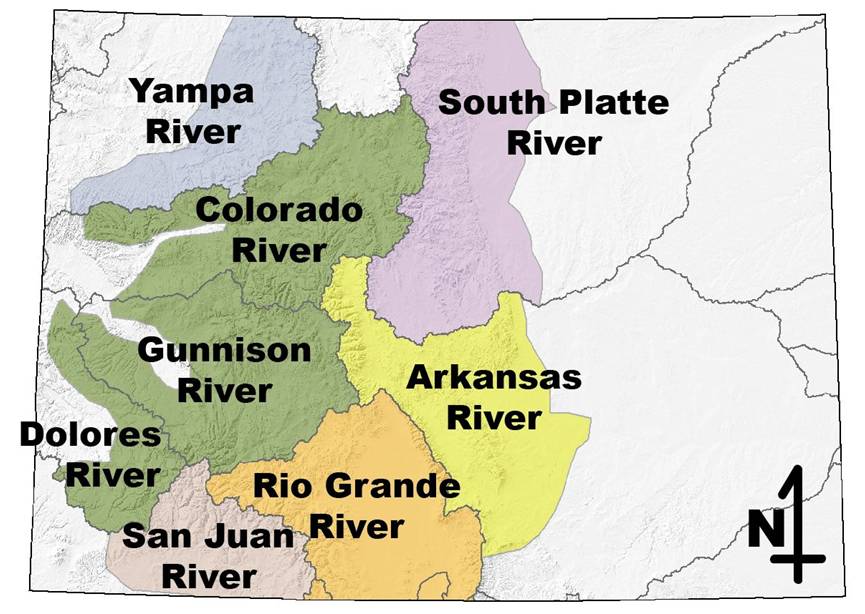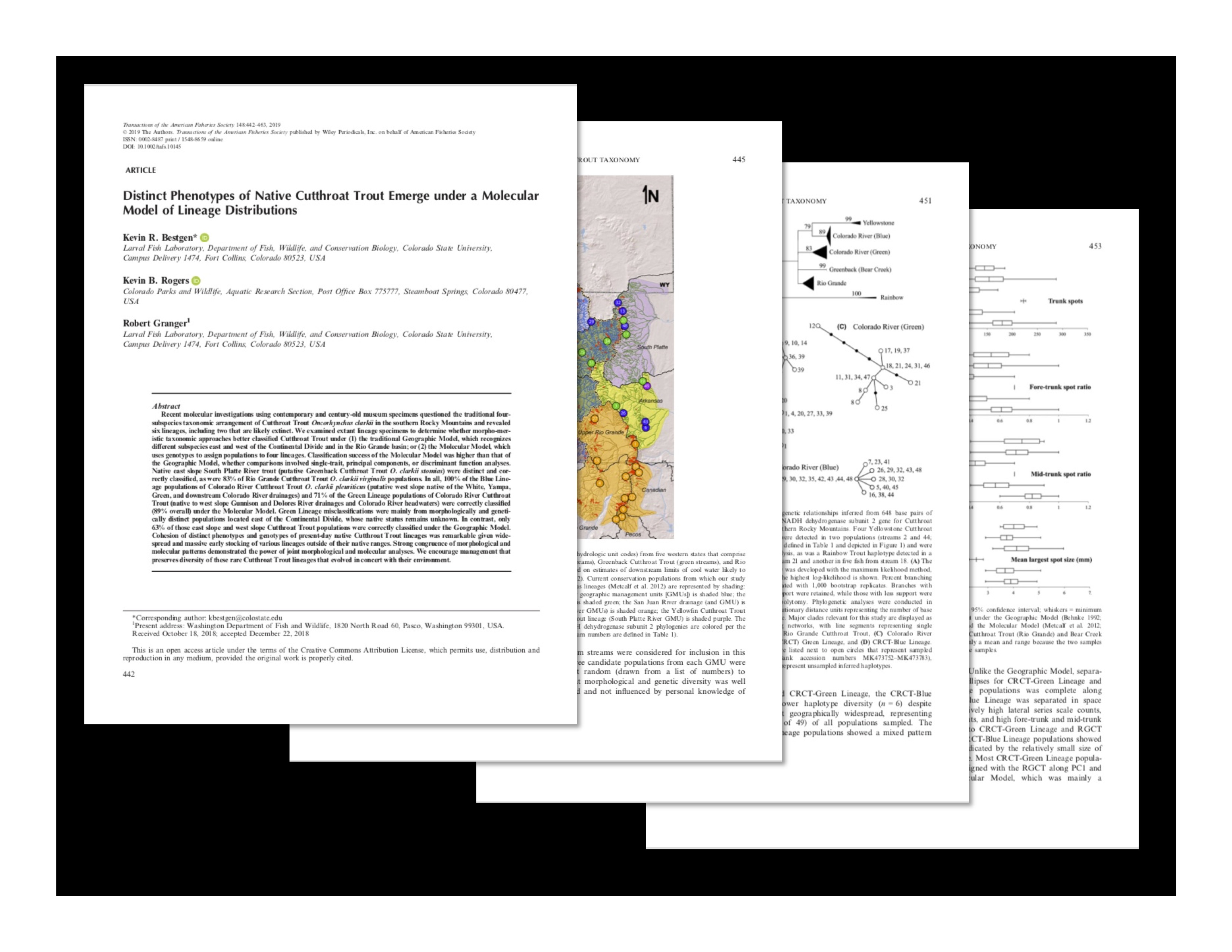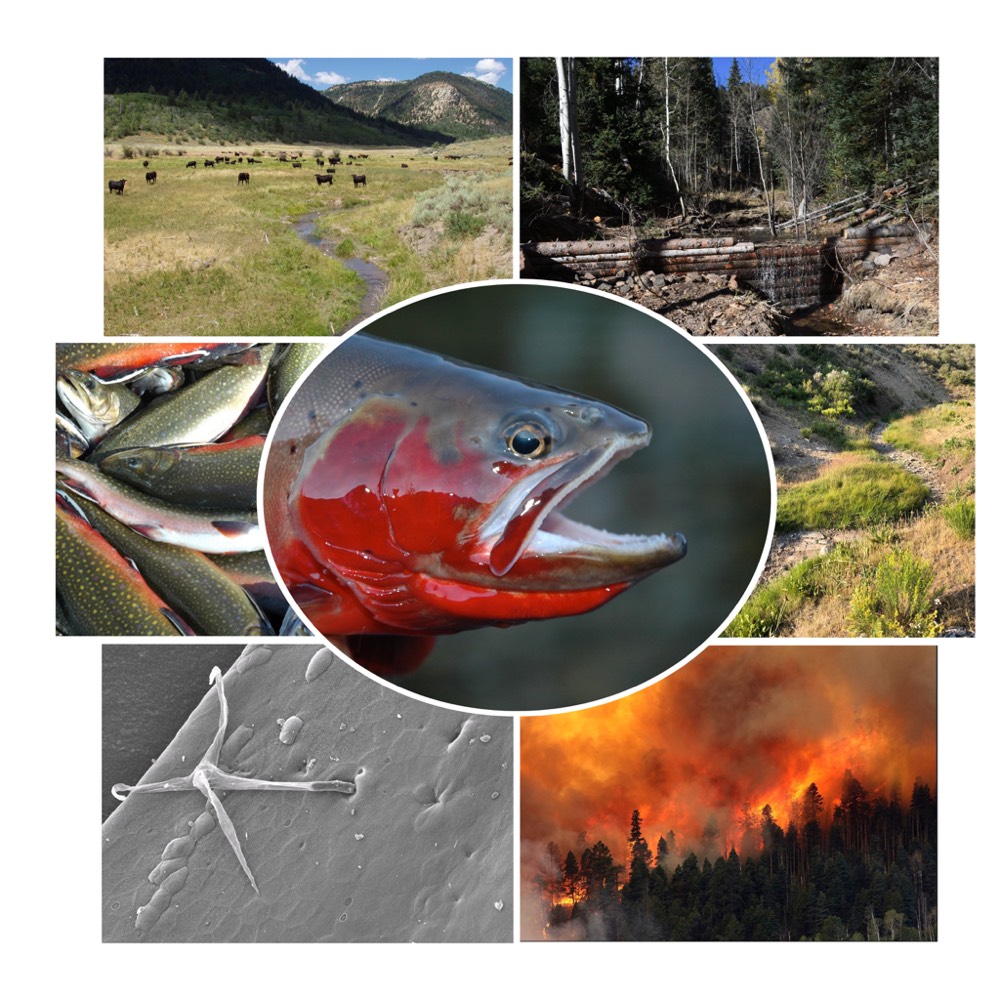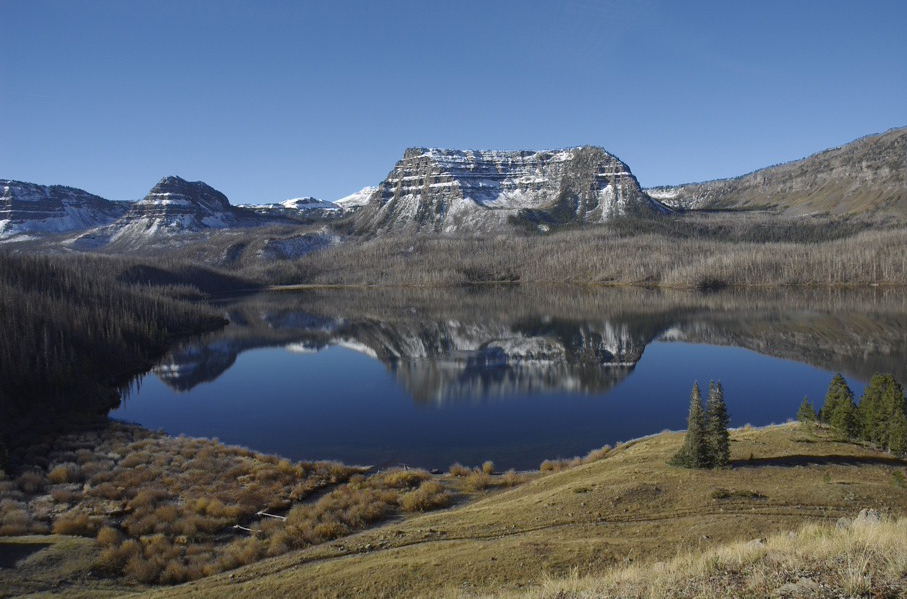Cutthroat Trout Conservation
The most diverse trout species in North America, the historical distribution of cutthroat trout covers the broadest range of any stream dwelling trout in the Western Hemisphere. The rugged topography of their range has lead to isolation, which in turn has given rise to fourteen recognized subspecies. Four of these evolved in Colorado: the
Colorado River cutthroat trout in drainages west of the continental divide,
Greenback cutthroat trout in the South Platte and Arkansas River drainages, and the
Rio Grande cutthroat trout in streams that drain into the San Luis Valley. In addition, the yellowfin cutthroat trout was historically found in Twin Lakes at the headwaters of the Arkansas drainage. Unfortunately, this predator that grew to over 10 lbs, is now extinct. All three remaining species have either been petitioned to be listed or are currently listed under the Endangered Species Act. Dramatic reductions in their range have been precipitated primarily by the introduction of nonnative salmonids. Specifically rainbow trout that hybridize with cutthroat trout, and brook and brown trout that tend to replace them in streams and rivers. In an effort to preserve the legacy of these fish, multi-agency conservation teams have been established for each subspecies.
Cutthroat Trout Recovery and Conservation Team documents:

Colorado River cutthroat trout

Greenback cutthroat trout

Rio Grande cutthroat trout
Cutthroat Trout Research
Taxonomy
New genetic
research led by University of Colorado scientists has produced several
fascinating discoveries about Colorado's native cutthroat trout - including the location of the last surviving wild population of the federally protected greenback cutthroat trout.
Researchers analyzed DNA extracted from wild trout and from museum specimens collected from sites around Colorado and New Mexico as far back as 1856, then used that genetic data as a baseline for understanding the current distribution of Colorado's native cutthroat trout.
In addition to identifying the one remaining "true" greenback population, researchers identified two distinct genetic lineages within the range of Colorado River cutthroat trout, one in northwest Colorado and the other centered around the Gunnison River basin. Further research will be needed to understand the relationship between these two lineages.
In all, six lineages of cutthroat appear to have evolved in Colorado, with native ranges that roughly correspond to major drainage basins in the state. The greenback cutthroat trout, Colorado's state fish, was native to the drainages of the South Platte, while the long extinct yellowfin cutthroat trout of Twin Lakes actually appears to have been the native trout of the Arkansas River Basin. Rio Grande cutthroat trout still can be found in streams that drain into the San Luis Valley, while a lineage that used to call the San Juan basin home appears to be extinct as well. More research will be required to resolve whether the remaining two lineages that can be found across Colorado’s western slope are indeed two distinct subspecies – that work is ongoing.

Native ranges of Colorado's six distinct lineages of cutthroat trout follow major drainage basins.
 Given that additional lineages of our native
cutthroat trout were identified with the DNA testing above, we wanted to determine if these lineages displayed different physical characteristics as well. This is particularly important since it has been argued that genetics should not be the sole factor in determining taxonomic distinctions, and that morphological traits (visual characteristics) are often better suited for discriminating taxa. A recent
comprehensive study examined the relationship between the differences implied by the DNA and the morphology of these fish. Indeed, it appears that these new lineages can also be identified by examining morphological traits as well.
Given that additional lineages of our native
cutthroat trout were identified with the DNA testing above, we wanted to determine if these lineages displayed different physical characteristics as well. This is particularly important since it has been argued that genetics should not be the sole factor in determining taxonomic distinctions, and that morphological traits (visual characteristics) are often better suited for discriminating taxa. A recent
comprehensive study examined the relationship between the differences implied by the DNA and the morphology of these fish. Indeed, it appears that these new lineages can also be identified by examining morphological traits as well.
Technical Reports
Wild spawn operations
A key element of cutthroat trout conservation involves the ability to take fertilized eggs from wild populations. Progeny from these operations are used for founding new populations in waters that have been cleared of nonnative fish that otherwise replace cutthroat trout or hybridize with them. Where habitats home to pure cutthroat trout have been invaded by nonnative salmonids, it important to replicate those populations before they wink out. Improving methods for obtaining fertilized eggs in the wild will facilitate those efforts.

CPW biologist Lori Martin takes spawn from cutthroat trout in Roan Creek. This population has been invaded by nonnative rainbow trout, and many of its residents are now hybridized. Families are raised separately at CPW's Research Hatchery in Fort Collins while DNA from the parents are tested. Only progeny from pure parents will be used to replicate this population in other waters.
Technical Reports
Cutthroat trout in a changing climate
 Like many coldwater fish species, cutthroat trout will face numerous additional challenges in a warming climate (see Dan Isaak's climate blog). State and federal researchers teamed up with Dr. Kurt Fausch of Colorado State University to develop a robust approach for synthesizing the myriad factors that will influence the persistence of remaining 121 individual conservation populations of Rio Grande cutthroat trout to 2080. Recently published as a featured paper in the North American Journal of Fisheries Management titled “Predicting persistence of Rio Grande Cutthroat Trout populations in an uncertain future”, the study found that although streams are predicted to warm by 2080, less than 10% of populations will be adversely affected. In contrast, nearly 65% are predicted to be extirpated (or nearly so) by nonnative trout that have already invaded or are expected to soon. Many populations will require the help of managers if they are to persist well into the 21st century. A manual for running the model can be found by clicking the link below
Like many coldwater fish species, cutthroat trout will face numerous additional challenges in a warming climate (see Dan Isaak's climate blog). State and federal researchers teamed up with Dr. Kurt Fausch of Colorado State University to develop a robust approach for synthesizing the myriad factors that will influence the persistence of remaining 121 individual conservation populations of Rio Grande cutthroat trout to 2080. Recently published as a featured paper in the North American Journal of Fisheries Management titled “Predicting persistence of Rio Grande Cutthroat Trout populations in an uncertain future”, the study found that although streams are predicted to warm by 2080, less than 10% of populations will be adversely affected. In contrast, nearly 65% are predicted to be extirpated (or nearly so) by nonnative trout that have already invaded or are expected to soon. Many populations will require the help of managers if they are to persist well into the 21st century. A manual for running the model can be found by clicking the link below
Technical Reports
Securing native cutthroat trout in Trappers Lake, Colorado
 Trappers Lake historically was home to Colorado’s premier wild Colorado River cutthroat trout fishery. Unfortunately, a variety of factors have served to suppress the current population as well as marginalize the value of the fishery due to introgression with Yellowstone cutthroat trout. Recent genetic surveys have revealed that the remaining cutthroat trout are a hybrid swarm. Reduced cutthroat trout numbers have been attributed to a burgeoning brook trout population that is now being thinned by fall trapping efforts. In addition, whirling disease invaded the population in the late 1990s, and has now firmly established itself suppressing recruitment of cutthroat trout further. In an effort to control the spread of the disease, anglers are reminded to decontaminate their gear after fishing at Trappers Lake particularly before heading into the higher elevation lakes such as Little Trappers Lake that remain free of the parasite.
Trappers Lake historically was home to Colorado’s premier wild Colorado River cutthroat trout fishery. Unfortunately, a variety of factors have served to suppress the current population as well as marginalize the value of the fishery due to introgression with Yellowstone cutthroat trout. Recent genetic surveys have revealed that the remaining cutthroat trout are a hybrid swarm. Reduced cutthroat trout numbers have been attributed to a burgeoning brook trout population that is now being thinned by fall trapping efforts. In addition, whirling disease invaded the population in the late 1990s, and has now firmly established itself suppressing recruitment of cutthroat trout further. In an effort to control the spread of the disease, anglers are reminded to decontaminate their gear after fishing at Trappers Lake particularly before heading into the higher elevation lakes such as Little Trappers Lake that remain free of the parasite.

